Indian Union Budget 2023-24 Key Highlight and Important Points
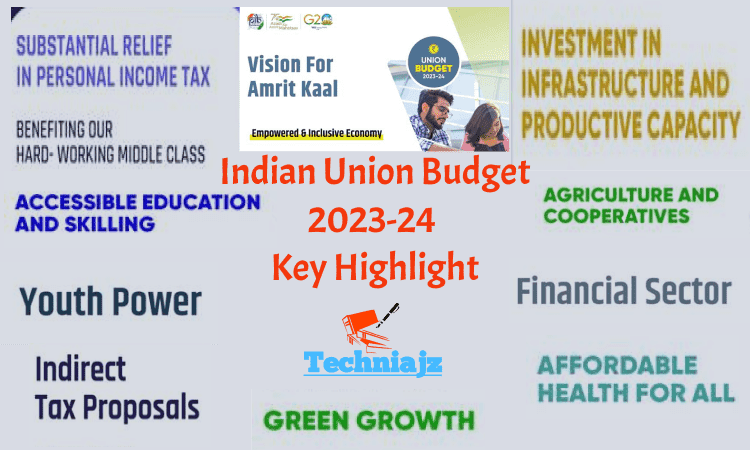
Despite the massive global slowdown caused by COVID-19 and the Russia-Ukraine War, the Indian economy is a bright star in the 75th year of India's Independence. Economic Growth is estimated at 7 percent, the highest rate among all major economies. During her presentation of the Union Budget 2023-24 before Parliament today, Union Finance & Corporate Affairs Minister Smt Nirmala Sitharaman stated this. Indian economic growth is on the right track, despite challenges, and the future is bright.
In her Budget address, Smt Sitharaman expressed the intention to build upon the foundations laid in the previous budget, as well as on India@100, a blueprint for a prosperous, inclusive India where the fruits of development reach all regions and citizens, especially our youth, women, farmers, OBCs, Scheduled Castes and Scheduled Tribes. In this blog, we will attempt to discuss all of the important points and highlights of the Union Budget 2023-24:
Table of Content:
- Previous Achievements of the Union Budgets
- Amrit Kaal's Vision' an Empowered and Inclusive Economy
- What are the Priorities Union Budget 2023-24
- Inclusive Development
- Reaching the Last Mile
- Infrastructure and Investment
- Unleashing the Potential
- Green Growth
- Youth Power
- Financial Sector
- Union Budget 2023-24 - Personal Income Tax
- Indirect Tax Proposals
The economy has grown much more structured, as evidenced by the EPFO enrolment more than tripling to 27 crores and 7,400 crore digital payments of Rs 126 lakh crore using UPI in 2022.
The Finance Minister stated that the proper implementation of several schemes, with universalization of specific target benefits, has resulted in inclusive development, naming some of the schemes as 11.7 crore household toilets under Swachh Bharat Mission, 9.6 crore LPG connections under Ujjawala, 220 crore Covid vaccinations of 102 crore people, 47.8 crore PM Jan Dhan Bank Accounts, Insurance cover for 44.6 crore people under PM Suraksha Bima and PM Jeevan Jyoti
She went on to say that the economic plan for realising this goal focuses on three things: giving enough chances for individuals, particularly young, to achieve their dreams, providing a strong impetus to development and job creation, and lastly, strengthening macroeconomic stability. She went on to say that the following four chances during Amrit Kaal can be transformative in serving these focal areas in our path to India@100 –
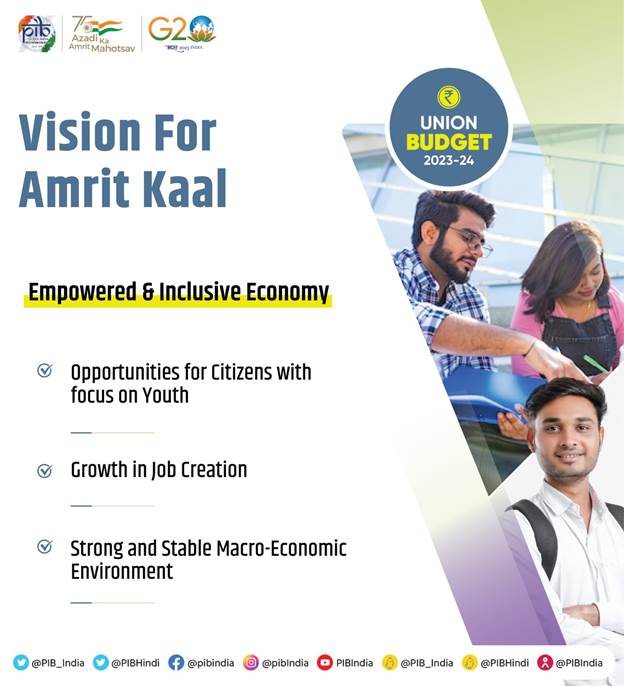
Economic Empowerment of Women: The Deendayal Antyodaya Yojana National Rural Livelihood Mission has achieved remarkable success by mobilizing rural women into 81 lakh Self Help Groups, and we will enable these groups to advance to the next stage of economic empowerment through the formation of large producer enterprises or collectives, each with several thousand members and professionally managed.
PM Vishwakarma Kaushal Samman (PM VIKAS): Traditional artists and crafters who work with their hands and equipment have given fame to India for millennia and are known as Vishwakarma. Their art and handicrafts exemplify the real essence of Atmanirbhar Bharat.
Tourism: According to the Finance Minister, the country is a huge draw for both local and foreign travelers, and there is a lot of potential in tourism. She added that the sector provides numerous opportunities for employment and entrepreneurship, particularly for young people, and that tourism promotion will be undertaken on a mission basis, with the active participation of states, the convergence of government programs, and public-private partnerships.
Green Growth: Concerning Green Growth, the FM stated that India is implementing several programmes for green fuel, green energy, green farming, green mobility, green buildings, and green equipment, as well as regulations for energy efficiency across diverse economic sectors. She noted that these green growth activities serve to reduce the carbon intensity of the economy and provide large-scale green job possibilities.
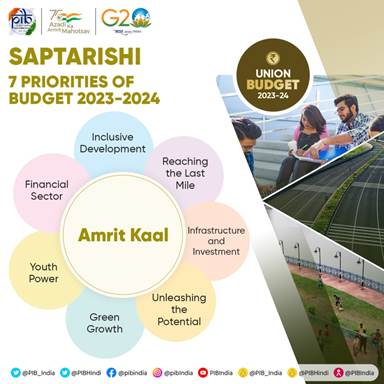
The government's Sabka Saath Sabka Vikas ideology has encouraged inclusive development, namely for farmers, women, youth, OBCs, Scheduled Castes, Scheduled Tribes, divyangjan, and economically disadvantaged sectors, as well as general priority for the poor (vanchiton ko variyata). A sustained emphasis has also been placed on Jammu and Kashmir, Ladakh, and the North-East. This Budget is an extension of their efforts.
Agriculture and Cooperation Sector:
A. Digital Public Infrastructure for Agriculture: Using appropriate information services for crop planning and health, greater access to farm inputs, loans, and insurance, crop estimating assistance, market intelligence, and support for the expansion of the agri-tech industry and start-ups, will allow inclusive, farmer-centric solutions.
B. Agriculture Accelerator Fund: The Agriculture Accelerator Fund will be established to foster agri-startups by young entrepreneurs in rural regions, with the goal of providing creative and inexpensive solutions to farmers' issues.
C. Enhancing Productivity of Cotton Crop: Through Public Private Partnerships, the government will use a cluster-based and value chain strategy (PPP).
D. Atmanirbhar Horticulture Clean Plant Programme: The government would invest Rs 2,200 crore in the Atmanirbhar Clean Plant Programme to increase the availability of disease-free, high-quality planting material for high-value horticulture crops.
E. Global Hub for Millets: ‘Shree Anna’: "India is at the forefront of popularising Millets, whose consumption furthers nutrition, food security and welfare of farmers". India is the world's largest producer and second largest exporter of 'Shree Anna,' growing numerous varieties such as jowar, ragi, bajra, kuttu, ramdana, kangni, kutki, kodo, cheena, and sama.
As India becomes a worldwide center for 'Shree Anna,' the Indian Institute of Millet Research in Hyderabad will be promoted as a Centre of Excellence for sharing best practices, research, and innovations at the international level.
F. Agriculture Credit: The government will establish a new sub-scheme of the PM Matsya Sampada Yojana with a planned investment of Rs 6,000 crore to further support the operations of fishermen, fish merchants, and micro and small companies, increase value chain efficiency, and grow the market.
G. Cooperation: A fresh Ministry of Cooperation was established with the mission of bringing the idea of 'Sahakar Se Samriddhi' to fruition. To realize this aim, the government has already begun the digitalization of 63,000 Primary Agricultural Credit Societies (PACS) with a Rs 2,516 crore investment.
Model bye-laws for PACS were developed in conjunction with all stakeholders and states, allowing them to become multifunctional PACS. A nationwide cooperative database is being created in order to map cooperative groups across the country.
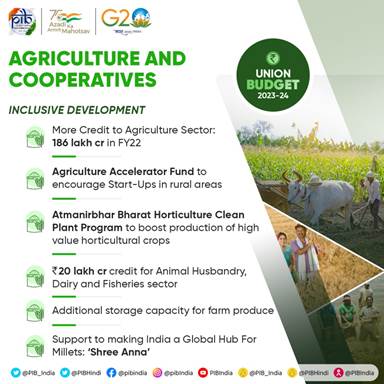
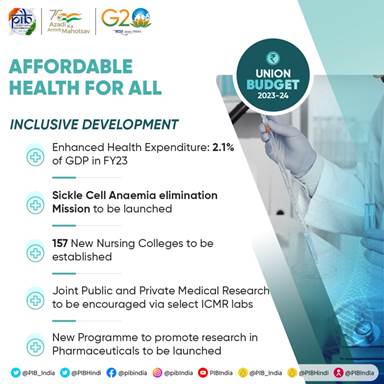
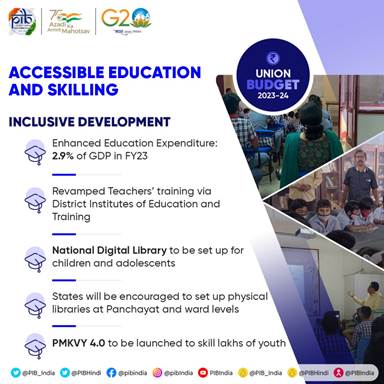
Health, Education, and Skilling Sector:
A. Medical & Nursing Colleges: The Finance Minister said that 157 new nursing colleges will be constructed in tandem with the existing 157 medical colleges established since 2014.
In terms of medical research, she stated that facilities in chosen ICMR Labs will be made available for research by public and private medical college professors and private sector R&D teams in order to encourage joint research and innovation. The government will also encourage companies to invest in R&D in important sectors.
B. Teachers’ Training: Innovative pedagogy, curricular transaction, continual professional development, dipstick surveys, and ICT deployment will be used to reimagine teacher training. For this goal, the District Institutes of Education and Training will be transformed into thriving centers of excellence.
The National Digital Library for Children and Adolescents will be established to provide access to high-quality books across geographies, languages, genres, and levels, as well as device independence. States will be encouraged to establish physical libraries at the panchayat and ward levels, as well as infrastructure to access the National Digital Library's resources.
The Finance Minister stated that Prime Minister Vajpayee's government had established the Ministry of Tribal Affairs and the Department of Development of the North-Eastern Region to bring the goal of "reaching the final mile" into clearer focus. FM stated that the Modi administration established the ministries of AYUSH, Fisheries, Animal Husbandry and Dairying, Skill Development, Jal Shakti, and Cooperation.
A. Aspirational Districts and Blocks Programme: The government recently established the Aspirational Blocks Programme, which covers 500 blocks and aims to provide fundamental government services in areas like health, nutrition, education, agriculture, water resources, financial inclusion, skill development, and basic infrastructure.
B. Pradhan Mantri PVTG Development Mission: Under the Development Action Plan for Scheduled Tribes, Rs 15,000 crore would be made available to undertake the Mission over the next three years. Smt Sitharaman said that the centre will hire 38,800 teachers and support personnel for the 740 Eklavya Model Residential Schools, which serve 3.5 lakhs, tribal kids, during the next three years.
C. Water for Drought Prone Region: The Finance Minister stated that federal assistance of Rs 5,300 crore will be provided to the Upper Bhadra Project in the drought-prone central area of Karnataka to ensure sustainable micro irrigation and the filling of surface tanks for drinking water.
D. PM Awas Yojana: In a crucial statement, the Finance Minister stated that the budget for the PM Awas Yojana has been increased by 66% to approximately Rs 79,000 crore.
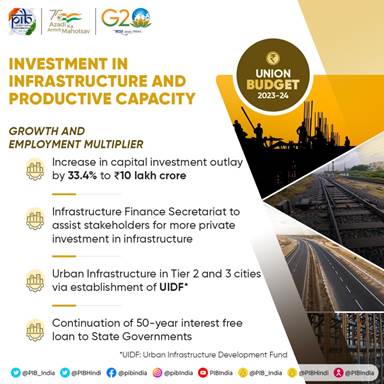
A. Support to State Governments for Capital Investment: The Finance Minister said that the government has chosen to extend the 50-year interest-free loan to state governments for another year in order to stimulate infrastructure investment and incentivize complementing policy initiatives, with a considerably increased expenditure of Rs 1.3 lakh crore.
B. Railways: The Finance Minister proposed a Rs 2.40 lakh crore capital investment for the Railways. One hundred important transport infrastructure projects for last and first-mile connections for the ports, coal, steel, fertilizer, and food grains sectors have been identified and will be prioritized with a Rs 75,000 crore investment, including Rs 15,000 crore from private sources. The government would give an annual allocation of Rs 10,000 crore for this objective.
According to the Finance Minister, more than 39,000 compliances have been lowered and more than 3,400 law provisions have been decriminalised in order to improve the ease of doing business. She went on to say that the government has presented the Jan Vishwas Bill to alter 42 Central Acts in order to strengthen trust-based governance.
A. Centres of Excellence for Artificial Intelligence: For accomplishing the aim of "Make AI in India and Make AI work for India", three centres of excellence for Artificial Intelligence will be establish at leading educational institutions.
B. National Data Governance Policy: A National Data Governance Policy will be released, allowing access to anonymised data in order to spur innovation and research by start-ups and academics. An Entity DigiLocker will be set up for MSMEs, major businesses, and charity trusts to utilise for securely storing and exchanging documents online with various authorities, regulators, banks, and other business entities as needed.
To actualize a new variety of options, economic models, and employment potential, 100 laboratories for creating applications employing 5G services will be established in engineering colleges.
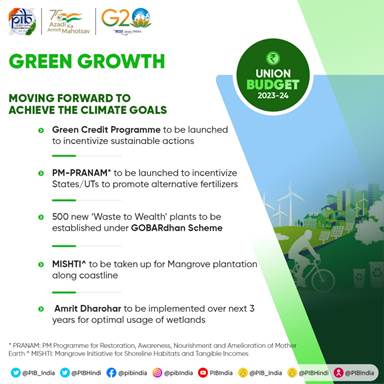
- The emphasis on green growth continues in this Budget. The recently formed National Green Hydrogen Mission, with a budget of Rs 19,700 crores, would help the economy transition to a low-carbon economy, reduce reliance on fossil fuel imports, and position India as a technical and market leader in this emerging industry. The goal is to attain 5 MMT in yearly output by 2030.
- The Ministry of Petroleum and Natural Gas also gets Rs 35,000 crore for priority capital investments in energy transition and net zero goals, as well as energy security.
- Battery Energy Storage Systems with a capacity of 4,000 MWH will be supported with Viability Gap Funding to lead the economy on a sustainable development path.
- The inter-state transmission line for evacuation and grid integration of 13 GW of renewable energy from Ladakh will cost Rs 20,700 crore, including Rs 8,300 crore in national support.
B. Bhartiya Prakritik Kheti Bio-Input Resource Centres: The Centre will help one crore farmers switch to organic farming. 10,000 Bio-Input Resource Centres will be established for this purpose, resulting in a countrywide dispersed micro-fertilizer and pesticide production network.
To empower the youth and assist the 'Amrit Peedhi' in realising their aspirations, the government has developed the National Education Policy, which focuses on skilling, enacted economic policies that promote large-scale employment creation, and encouraged entrepreneurial prospects.
- Within the next three years, the Pradhan Mantri Kaushal Vikas Yojana 4.0 will be launched to skill lakhs of youth. On-the-job training, industry collaboration, and course alignment with industry demands will be highlighted.
- The programme will also include new age courses for Industry 4.0 such as coding, AI, robotics, mechatronics, IOT, 3D printing, drones, and soft skills.
- 30 Skill India Foreign Centres will be established across several states to prepare youngsters for international chances.
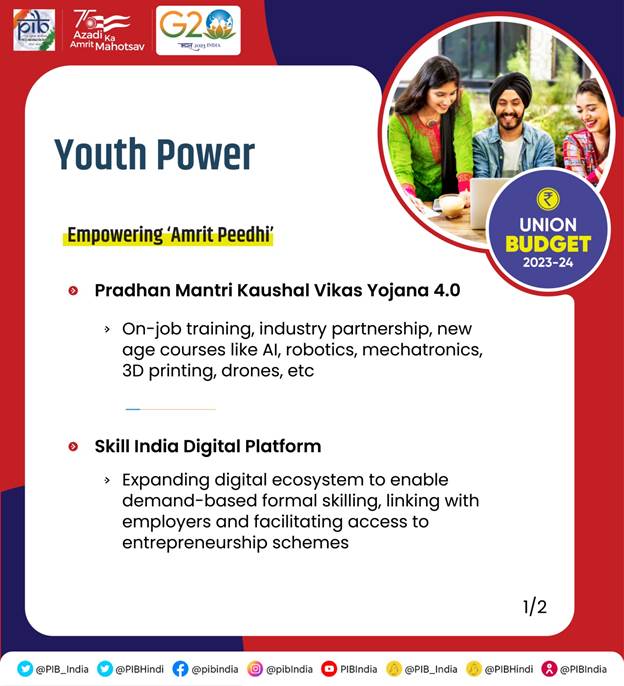
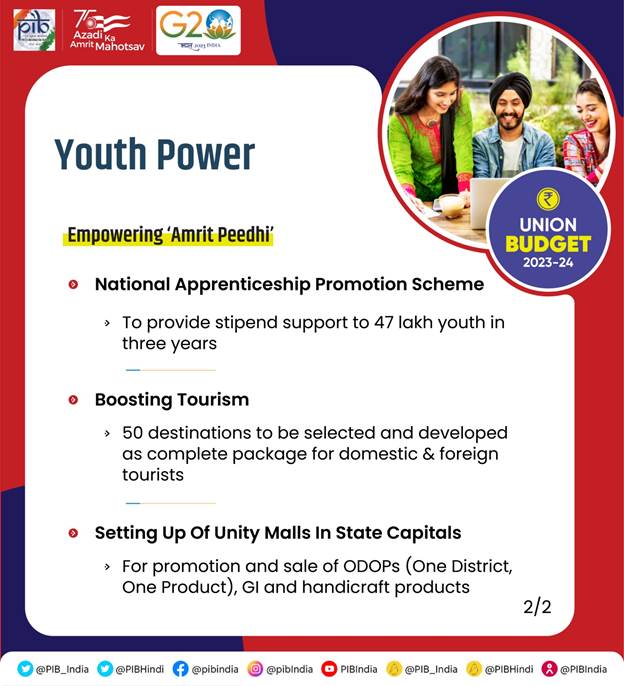
A. National Apprenticeship Promotion Scheme: Direct Benefit Transfer would be implemented as part of a pan-India National Apprenticeship Promotion Scheme to give stipend assistance to 47 lakh youth over the next three years.
B. Unity Mall: States will be encouraged to build a Unity Mall in one‘s state capital or the most prominent tourism centre or financial capital for the advancement and sale of their own ODOPs (one district, one product), GI products, and other handicraft products, as well as to provide space for such products from other states.
A. Credit Guarantee for MSMEs: The loan guarantee plan for MSMEs has been revised, and the new scheme will go into action on April 1, 2023, with an investment of Rs 9,000 crore into the corpus. This will provide for an extra Rs 2 lakh crore of collateral-free guaranteed loans. Furthermore, the credit cost will be lowered by around 1%.
For Azadi Ka Amrit Mahotsav, a one-time new modest savings programme, Mahila Samman Savings Certificate, will be made available for a two-year period ending in March 2025. This would provide a deposit facility of up to Rs 2 lakh in the name of women or girls for a period of two years at a fixed interest rate of 7.5% with the option of partial withdrawal.
B. Senior Citizens: The Senior Citizen Savings Scheme's maximum deposit limit will be raised from Rs 15 lakh to Rs 30 lakh.
The monthly deposit limit for the Monthly Income Account Scheme will be increased from Rs 4.5 lakh to Rs 9 lakh for single accounts and from Rs 9 lakh to Rs 15 lakh for joint accounts.
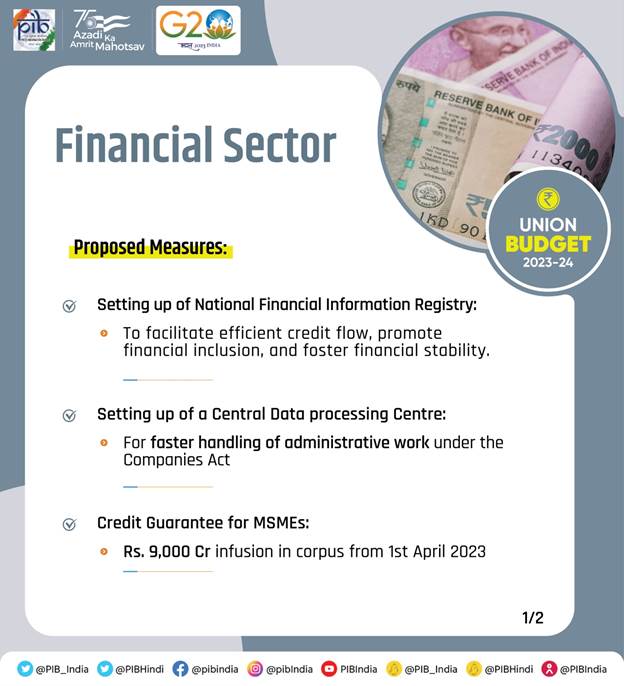
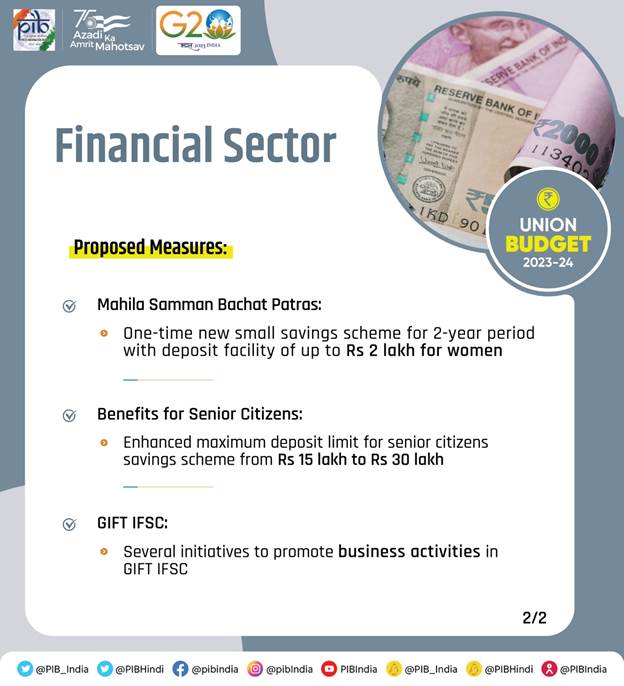
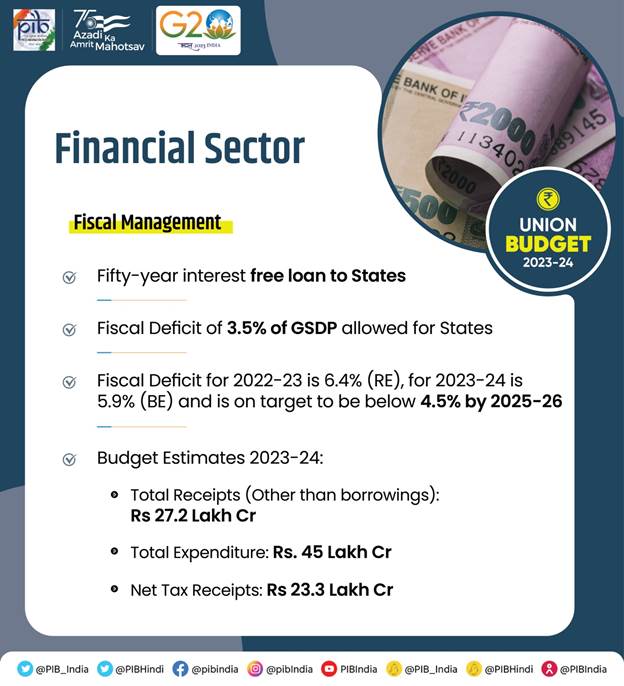
C. Fiscal Management: Total collections other than borrowings are estimated to be Rs 24.3 lakh crore in the Revised Estimate, with net tax receipts of Rs 20.9 lakh crore. The entire spending is estimated to be Rs 41.9 lakh crore, with capital expenditure amounting to around Rs 7.3 lakh crore. Similarly, the Revised Estimate of the fiscal deficit, which is consistent with the Budget Estimate, is 6.4% of GDP.
D. Budget Estimates 2023-24: Total earnings other than borrowings are anticipated to be Rs 27.2 lakh crore and total spending to be Rs 45 lakh crore, respectively. The expected net tax collections are Rs 23.3 lakh crore. The fiscal deficit is anticipated to be 5.9% of GDP.
Approximate market borrowings from dated securities are anticipated to be Rs11.8 lakh crore in 2023-24 to cover the fiscal deficit. Small savings and other sources are likely to provide the remaining funding. The total amount of gross market borrowings is anticipated to be Rs 15.4 lakh billion.
The current budget indirect tax initiatives aim to boost exports, increase domestic value addition, and promote green energy and transportation.
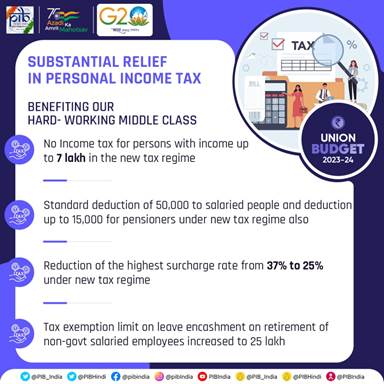
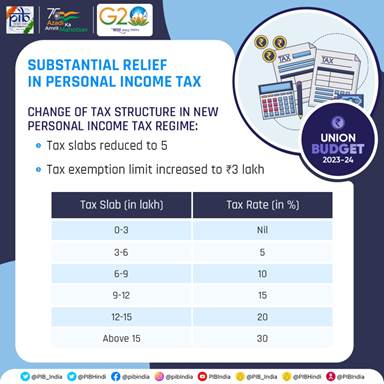
- The rebate maximum under the new tax regime has been extended to 7 lakhs, which means that peons in the new tax system would not have to pay any tax on income up to 7 lakhs. The new personal tax system has modified the tax structure by lowering the number of slabs to five and boosting the tax exemption ceiling to 3 lakhs. This will bring significant relief to all taxpayers under the new regime.
- Under the new tax regime, the benefit of standard deduction has been extended to salaried workers and seniors, including family pensioners. According to the idea, salaried individuals will receive a basic deduction of $50,000, while pensioners will receive a deduction of $15,000. From the foregoing ideas, any salaried individual earning 15.5 lakh or more will get 52,500.
- The maximum surcharge rate in personal income tax has been decreased from 37% to 25% in the new tax system for income beyond 2 crore. This would reduce the maximum personal income tax rate from 42.74% to 39%.
- The tax exemption ceiling for non-government paid employees on leave encashment on retirement has been enhanced from 3 lakh to 25 lakh.
- The new income tax system has been designated as the default tax system. However, citizens will still be able to take advantage of the existing tax structure.
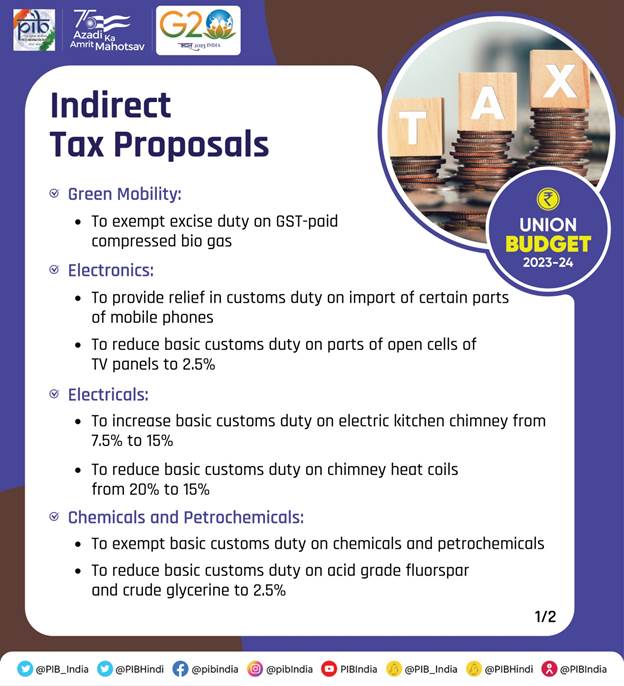
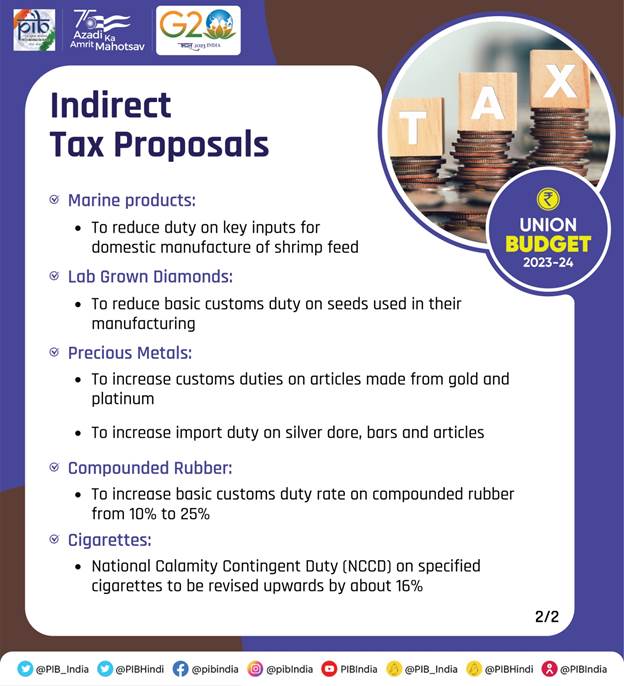
- Other than textiles and agriculture, the number of basic customs tax rates has been cut from 21 to 13. Toys, bicycles, autos, and naphtha are among the commodities subject to small modifications in basic customs taxes, cesses, and surcharges.
- Excise charge on GST-paid compressed bio-gas contained in it has been exempted from excise duty to avoid a cascade of taxes on blended compressed natural gas.
- The import of capital goods and machinery necessary for the fabrication of lithium-ion cells for batteries used in electric cars is now duty-free.
- The basic customs tax on open cell portions of TV panels has been decreased to 2.5%.
- The Budget also recommends revisions to the basic customs tax in order to correct the inversion of duty structure and boost the production of electrical kitchen chimneys.
- Basic customs tax has been waived for denatured ethyl alcohol. The basic customs tax on acid grade fluorspar and crude glycerin has also been decreased.
- Duty on major ingredients for domestic shrimp feed production is being decreased.
- The basic customs tax on seeds used in the production of Lab Grown Diamonds has been decreased as well.
- Import duties on silver dore, bars, and articles have been raised to match those on gold and platinum.
- Compounded rubber's basic customs tax rate has been raised.
- The National Calamity Contingent Duty on certain cigarettes has been increased by approximately 16%.
- It is suggested to cut the basic customs tax on crude glycerin used in the production of epicholorhydrin from 7.5% to 2.5%.
- The Budget recommends extending the deadline of incorporation for income tax advantages to new businesses from March 31, 2023 to March 31, 2024. It also allows start-ups to carry forward losses on changes in ownership from 7 to 10 years after formation.
Source of Information and Images: PIB India and National Portal of India
Indian Union Budget 2023-24 Indian Union Budget Key Highlight Indian Union Budget Important Points Indian Union Budget Union Budget of Indian Union Budget 2023-24 Personal Income Tax Indirect Tax Proposals Previous Achievements of the Union Budgets Amrit Kaals Vision Empowered and Inclusive Economy Priorities Union Budget 2023-24 Inclusive Development Reaching the Last Mile Infrastructure and Investment Unleashing the Potential Green Growth Youth Power Financial Sector
Comments